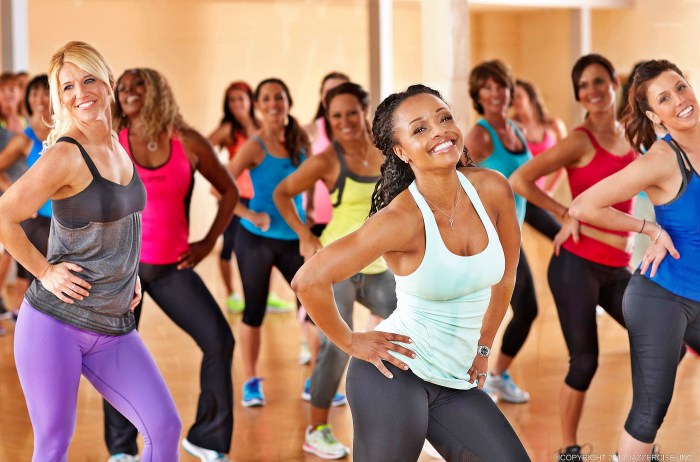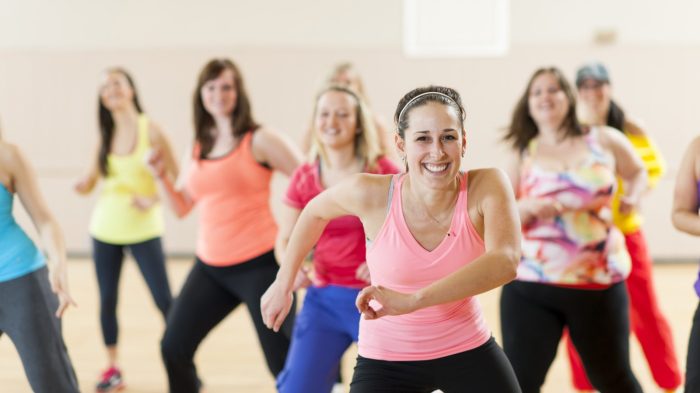
Dance fitness classes for fun and cardio set the stage for this enthralling narrative, offering readers a glimpse into a story that is rich in detail and brimming with originality from the outset.
As we delve into the world of dance fitness, we uncover the numerous benefits it brings to cardiovascular health and overall fitness. From popular dance styles to structuring a class session, this guide will illuminate how dance can be both enjoyable and beneficial for your heart and body.
Dance Fitness Classes for Fun and Cardio

Dance fitness classes are not only enjoyable but also provide numerous benefits for cardiovascular health and overall fitness levels. By engaging in these classes, participants can experience improvements in their physical and mental well-being.
Benefits of Dance Fitness Classes for Cardiovascular Health
Dance fitness classes involve continuous movement and rhythmic patterns that elevate the heart rate, leading to improved cardiovascular health. Through regular participation, individuals can strengthen their heart muscles, increase lung capacity, and enhance circulation throughout the body.
Improving Overall Fitness Levels through Dance Fitness Classes
In addition to cardiovascular benefits, dance fitness classes can also contribute to improving overall fitness levels. These classes incorporate a variety of movements that target different muscle groups, helping to enhance flexibility, strength, and endurance. The dynamic nature of dance routines can also boost coordination and balance, leading to a more well-rounded fitness regimen.
Popular Dance Fitness Styles for Fun and Cardio Workouts
Zumba
A high-energy dance workout that combines Latin and international music with fun choreography.
Hip Hop Dance Fitness
Incorporates urban dance moves set to hip hop music for a lively and engaging workout.
Jazzercise
A fusion of jazz dance, resistance training, Pilates, yoga, and kickboxing for a full-body workout.
Bollywood Dance Fitness
Draws inspiration from Indian cinema, blending traditional dance styles with modern fitness techniques.
Salsa Dance Fitness
An energetic dance form that emphasizes rhythmic footwork and partner movements for a social and dynamic workout experience.
Dance Fitness Class Structures

When it comes to dance fitness classes, the structure typically follows a similar format to ensure a well-rounded workout experience. Let’s dive into the typical components of a dance fitness class session.
Duration of a Dance Fitness Class Session
A typical dance fitness class session usually lasts around 45 minutes to an hour. This duration allows for a comprehensive workout while keeping the energy levels up throughout the class.
Components of a Typical Dance Fitness Class
- Warm-up:The class usually starts with a warm-up session to prepare the body for the upcoming workout. This segment helps to increase blood flow, flexibility, and reduce the risk of injuries.
- Main Routine:The main part of the class involves learning and performing dance routines that are designed to elevate the heart rate, burn calories, and improve coordination. This is where the fun and energetic dance moves come into play.
- Cool Down:Towards the end of the class, there is a cool-down segment that focuses on stretching and slowing down the heart rate. This helps the body to recover and prevents muscle soreness.
Different Dance Fitness Class Formats
- High-Intensity:High-intensity dance fitness classes incorporate fast-paced movements and intense cardio exercises to really get your heart pumping and burn those calories quickly.
- Low-Impact:Low-impact dance fitness classes are gentler on the joints and are suitable for individuals looking for a less intense workout while still enjoying the benefits of dancing.
- Dance Styles:Dance fitness classes can also be categorized based on the dance styles incorporated, such as hip-hop, salsa, Zumba, or even Bollywood. Each style offers a unique experience and targets different muscle groups.
Importance of Dance in Cardiovascular Health
Dance is not only a fun and engaging activity, but it also offers numerous benefits for cardiovascular health. By incorporating dance into your fitness routine, you can effectively elevate your heart rate, improve cardiovascular endurance, promote weight loss, burn calories, reduce the risk of heart disease, and enhance circulation.
Elevating Heart Rate and Improving Cardiovascular Endurance
Dance involves continuous movement and rhythmic patterns that can significantly increase your heart rate. This sustained elevation in heart rate during dance sessions helps strengthen the heart muscle over time, improving cardiovascular endurance. As a result, your heart becomes more efficient at pumping blood and oxygen throughout your body, enhancing overall heart health.
Promoting Weight Loss and Burning Calories
Engaging in dance fitness classes can be an effective way to shed unwanted pounds and maintain a healthy weight. The combination of high-energy dance routines and aerobic movements helps burn a significant number of calories. Continuous movement in dance routines increases metabolism, leading to calorie burn not only during the class but also throughout the day.
This calorie deficit can contribute to weight loss when combined with a balanced diet.
Reducing the Risk of Heart Disease and Improving Circulation
Regular participation in dance can have a positive impact on reducing the risk of heart disease. Dance helps lower blood pressure, improve cholesterol levels, and reduce inflammation in the body, all of which are crucial factors in preventing heart disease.
Additionally, the rhythmic movements in dance enhance circulation by promoting better blood flow to all parts of the body, ensuring that vital organs receive an adequate supply of oxygen and nutrients.
Choosing the Right Dance Fitness Class
When it comes to choosing the right dance fitness class, it’s essential to consider various factors to ensure it aligns with your fitness level, preferences, and goals. Whether you’re a beginner or experienced dancer, finding the perfect class can make a significant difference in your overall experience and results.
Considerations for Fitness Level
- Assess your current fitness level: Before selecting a dance fitness class, evaluate your fitness level to determine whether you’re a beginner, intermediate, or advanced dancer.
- Look for classes tailored to your level: Choose a class that aligns with your skills and abilities to ensure you can follow along comfortably and progress effectively.
- Gradually challenge yourself: If you’re looking to improve your fitness level, consider stepping slightly out of your comfort zone without overexerting yourself.
In-Person vs. Online Classes
- Convenience vs. Interaction: In-person classes provide a social and interactive environment, while online sessions offer the flexibility of working out from home.
- Evaluate your preferences: Consider whether you prefer the energy of a group setting or the convenience of joining virtual classes to make the right choice.
- Quality of instruction: Ensure that the class you choose, whether in-person or online, offers professional guidance and proper form correction to maximize your workout benefits.
Finding Balance in Fun and Cardio
- Vary your classes: Incorporate a mix of dance fitness classes that focus on different styles and intensity levels to keep your workouts exciting and engaging.
- Listen to your body: Pay attention to how your body responds to each class and adjust the intensity based on your energy levels and fitness goals.
- Add supplementary cardio: If you feel a class is more focused on fun than cardio, supplement your routine with additional cardiovascular exercises to maintain a balanced workout regimen.
Incorporating Dance Fitness into a Workout Routine
Dance fitness classes can be a fantastic addition to your workout routine, offering a fun and effective way to improve cardiovascular health while also enhancing strength and flexibility. By integrating dance fitness with other forms of exercise, you can create a well-rounded workout that keeps you engaged and motivated.
Complementing Strength Training
- Consider incorporating dance fitness on days when you are not focusing on strength training. This can help improve your endurance and stamina, leading to better overall performance during strength workouts.
- Dynamic dance movements engage various muscle groups, providing a full-body workout that complements traditional strength training exercises.
- Adding dance fitness to your routine can break the monotony of lifting weights or doing bodyweight exercises, making your workouts more enjoyable.
Enhancing Flexibility
- Dance fitness involves a wide range of motion and stretches that can improve flexibility and mobility.
- Incorporating dance routines that focus on stretching and lengthening muscles can help prevent injuries and promote better overall flexibility.
- Combining dance fitness with targeted stretching exercises can lead to increased flexibility over time, enhancing your overall fitness level.
Creating a Balanced Schedule
- Allocate specific days or times in your weekly schedule for dance fitness classes to ensure consistency and adherence to your workout routine.
- Balance high-intensity dance sessions with lower-impact activities or rest days to prevent overtraining and allow for proper recovery.
- Gradually increase the frequency and duration of your dance fitness sessions as your stamina and endurance improve, aiming for at least 150 minutes of moderate-intensity aerobic activity per week.
Health and Medical Considerations

Consulting with a healthcare provider before starting a new dance fitness regimen is crucial to ensure that the exercise is safe and appropriate for your individual health needs. Your healthcare provider can provide guidance on any modifications that may be necessary based on your medical history or current health status.
Contribution to Mental Health and Stress Reduction
Dance fitness classes offer not only physical benefits but also contribute to mental well-being and stress reduction. The combination of movement to music, social interaction, and the release of endorphins during exercise can help reduce stress, improve mood, and boost overall mental health.
- Dance fitness can serve as a form of therapy, allowing participants to express themselves creatively and emotionally through movement.
- The rhythmic and repetitive nature of dance can help calm the mind and reduce anxiety levels.
- Engaging in a fun and energetic dance workout can distract from daily stressors and provide a mental break.
Improvement in Coordination, Balance, and Agility
Participating in dance fitness classes regularly can lead to improvements in coordination, balance, and agility. The varied movements and sequences in dance routines challenge different muscle groups and help enhance overall motor skills.
- Dance requires coordination between different parts of the body, promoting better overall balance and spatial awareness.
- The dynamic and fluid movements in dance routines help improve agility and reaction time.
- Learning and mastering new dance steps can enhance cognitive function and motor skills, benefiting coordination and balance.
Outcome Summary
In conclusion, dance fitness classes offer a unique blend of fun and cardio, making them a versatile and effective way to improve cardiovascular health. Whether you are a beginner or an experienced dancer, incorporating these classes into your routine can lead to a healthier and happier lifestyle.
Dive into the world of dance fitness and discover a new way to stay active and energized.
FAQ Explained
What are the benefits of dance fitness classes for cardiovascular health?
Dance fitness classes can improve heart health, increase endurance, and enhance overall cardiovascular fitness through rhythmic movements and aerobic exercises.
How can dance fitness improve overall fitness levels?
By incorporating dance into workouts, individuals can enhance their coordination, agility, and flexibility while burning calories and improving cardiovascular endurance.
What are some popular dance fitness styles for fun and cardio workouts?
Popular dance fitness styles include Zumba, hip-hop, salsa, and ballet-inspired workouts that combine fun choreography with cardiovascular benefits.
How long is a typical dance fitness class session?
A typical dance fitness class session usually lasts between 45 minutes to an hour, allowing participants to engage in a full-body workout.
How can dance fitness reduce the risk of heart disease?
Regular participation in dance fitness can help lower blood pressure, improve circulation, and reduce stress levels, all of which contribute to a healthier heart and reduced risk of heart disease.





